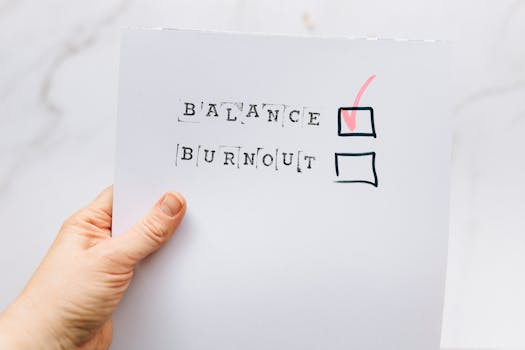What is burnout prevention tactics?

What is burnout prevention tactics?
Burnout is more than just a buzzword; it’s a significant issue that affects countless people in their lives and workplaces. It manifests as that overwhelming sense of fatigue, cynicism, and detachment that can drain your energy and joy. Recognizing the signs of burnout is crucial because, without effective prevention tactics, it can lead to severe consequences for your mental and physical health. This article will dive into burnout prevention tactics, helping you understand its effects and offering practical strategies to combat it.
Understanding Burnout
Burnout is a state of emotional, physical, and mental exhaustion caused by prolonged and excessive stress. It can lead to feelings of helplessness, frustration, and a sense of being overwhelmed. According to the American Psychological Association, burnout can result in reduced productivity, absenteeism, and increased health issues. It’s alarming to note that studies show burnout can contribute to chronic diseases like heart disease, depression, and anxiety.
Burnout isn’t just personal; it affects workplace dynamics too. A 2022 study found that employees experiencing high levels of burnout showed significantly lower productivity, leading to negative outcomes for both individuals and organizations.
What Causes Burnout?
Several factors contribute to burnout, and understanding these causes can help address the issue before it escalates. Common stressors include:
- Workload: Excessive responsibilities can lead to feelings of being overwhelmed.
- Lack of Control: Employees who feel they have little power over their tasks often experience burnout.
- Insufficient Rewards: When hard work goes unrecognized, motivation can plummet.
- Unclear Job Expectations: Ambiguity in roles can create confusion and stress.
These factors can feed into each other, creating a cycle that’s tough to break. For more insights on burnout causes, check out this comprehensive resource.
Recognizing the Signs of Burnout
Identifying burnout early can be your best defense. Key symptoms to watch for include:
- Emotional Exhaustion: Feeling drained and depleted, often resulting in a lack of motivation.
- Cynicism: Developing a negative outlook towards work and colleagues.
- Reduced Professional Efficacy: Struggling to find satisfaction in accomplishments or feeling ineffective.
If you notice these signs, it might be time to explore some burnout prevention tactics.
Effective Burnout Prevention Tactics
Now that we’ve covered the basics of burnout, let’s explore actionable strategies for prevention. These tactics can help maintain your mental and emotional well-being.
Time Management Techniques
Effective time management can significantly reduce the risk of burnout. Here are a few methods you can apply:
- Pomodoro Technique: Work in focused sprints of 25 minutes, followed by short breaks. This can boost productivity while preventing fatigue.
- Time Blocking: Allocate specific time slots for tasks to create structure in your day. Prioritizing tasks ensures that you’re focusing on what truly matters.
By mastering these techniques, you can maximize productivity while avoiding the pitfalls of overwork.
Setting Boundaries
Establishing boundaries is essential for maintaining a healthy work-life balance. This involves saying “no” when necessary and being clear about your limits. When you protect your time and energy, you’re better positioned to fend off burnout.
Regular Breaks and Downtime
Taking regular breaks during the day is vital for recharging your mental batteries. Schedule downtime to step away from your work—whether it’s a quick walk, stretching, or even just a few moments of deep breathing. These breaks can make a significant difference in your overall energy levels.
Mindfulness and Stress Reduction Practices
Incorporating mindfulness into your routine can be transformative. Here are a few practices to consider:
- Meditation: Spend a few minutes each day meditating to clear your mind and reduce stress.
- Yoga: This practice not only improves physical health but also encourages mental clarity and relaxation.
- Deep Breathing Exercises: Simple deep breathing can help calm your nervous system and reduce stress.
These techniques have been shown to mitigate stress effectively, as highlighted in this study.
Seeking Support
Don’t hesitate to reach out for help if you’re feeling overwhelmed. Whether it’s talking to friends, family, or even a mental health professional, seeking support can provide you with resources and perspectives to navigate burnout.
Creating a Sustainable Work Culture
Organizations play a critical role in preventing burnout. Here are some strategies companies can implement:
Encouraging Open Communication
Establishing an environment where employees feel comfortable discussing their stressors can help identify issues before they escalate. Open dialogue fosters trust and promotes a healthier workplace culture.
Flexible Work Arrangements
Offering flexible schedules or remote work options can empower employees to manage their workloads better. This flexibility can lead to improved morale and productivity, allowing individuals to balance work and personal responsibilities more effectively.
Regular Assessments and Check-Ins
Employers should conduct regular mental health check-ins with employees. These assessments can help identify signs of burnout early, allowing for timely interventions and support.
Conclusion
Burnout is a serious issue that can impact both personal and professional lives. However, by implementing effective burnout prevention tactics such as time management techniques, setting boundaries, and practicing mindfulness, we can significantly reduce its likelihood. It’s crucial to take proactive measures for ourselves and advocate for changes in our workplaces to foster a healthier work environment. Remember, preventing burnout isn’t just about working harder; it’s about working smarter and prioritizing well-being. Start today, and take the first step toward a healthier, happier you.